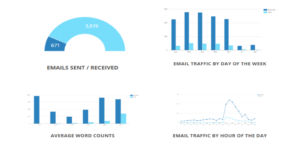There are analytics apps for a variety of functions, including measuring the effectiveness of marketing campaigns, website traffic, and even employee productivity through time tracking apps. But there are multiple problems with analyzing worker productivity with time tracking alone.
For example, time tracking tends to be subjectively reported, it can be manually edited after a piece of work is done, and time tracking alone doesn’t indicate the quality of the work performed. That doesn’t even include the learning curve that some time tracking apps present, or flaws with individual platforms.
If you really want to master you and your employees’ productivity, you have to dig deeper into the daily activities that comprise their work—and now there’s an app that does just that for email activity – EmailAnalytics.
The basis of EmailAnalytics is mining and visualizing data related to your email habits. The goal is to help managers and individuals understand the weak points of their current email habits, including especially time-consuming clients and coworkers, longer-than-average draft times, and overly complex messaging formats.
So how does EmailAnalytics work?
The integration process is simple. You simply log in using a Gmail or G Suite account, and the tool will immediately begin pulling, aggregating, and visualizing data related to your email habits. The app is set up much like Google Analytics, with interactive menus that allow you to customize your reports, and see changes in your habits over time.
The app measures things like the amount of emails you send and receive, email traffic by day of the week, hour of the day, average response times, and much more. Additionally, it allows managers to sync their employees’ accounts so employee email productivity can be tracked.
How Much Time Do You Spend on Email?
You may be wondering why email is such an important element of productivity. After all, many workers see email as an afterthought, or as a necessary byproduct of their “real” work.
However, it’s likely that you spend far more time on email than you realize; in fact, some surveys estimate the average workers spends 6.3 hours a day on email alone. The Washington Post has a handy (and somewhat depressing) calculator where you can calculate the amount of time you spend personally—but unless you’re an outlier, you probably spend at least several hours a day as well.
With that high volume and prevalence, even minor changes to your email productivity could free up hours of extra time every week. Plus, as you refine your emailing efficiency and quality, you’ll become a better communicator, and you’ll prevent miscommunications that can cause even greater damage to your effectiveness.
Possible Improvements
So what can you hope to gain from using an app like EmailAnalytics? Once you understand your email habits (and potentially the habits of your team, if you have one), you can improve the following, at a minimum:
- Time spent writing and reading. First, you’ll be able to address any problems with the amount of time it takes you to write or read emails. Are you a slow writer? You can work on writing more concisely. Do you take longer to read emails than others? Practice speed reading.
- Root cause analysis. At least some of your time loss in emailing will be linked to other people who aren’t good at it. Email analytics can help you identify problematic clients or employees who force you to spend twice as long on their emails because they aren’t effective communicators.
- Conversational optimization. You can also use this data to sculpt the conversational threads that circulate within your organization. Is there one member of your team who seems to start the most conversational threads? Do your email chains grow unmanageable too quickly, spanning several dozen messages from as many contributors?
- Project costs and ROI. You can also use these data to estimate your total project costs, as well as the return on investment (ROI) associated with those projects. It’s easy to neglect the amount of time your employees spend emailing clients and each other, but it’s an important cost to consider.
Like with most analytics apps, you stand to gain benefits proportional to the effort you put in using it. The more you dig into your habits and the more you learn about your behavior, the more potential changes you can learn to make, and the further you can advance in terms of email efficiency.
The qualitative assessment of your emails will be left to you—but once you know the objective root causes of your productivity losses, the picture will be much clearer to see.








